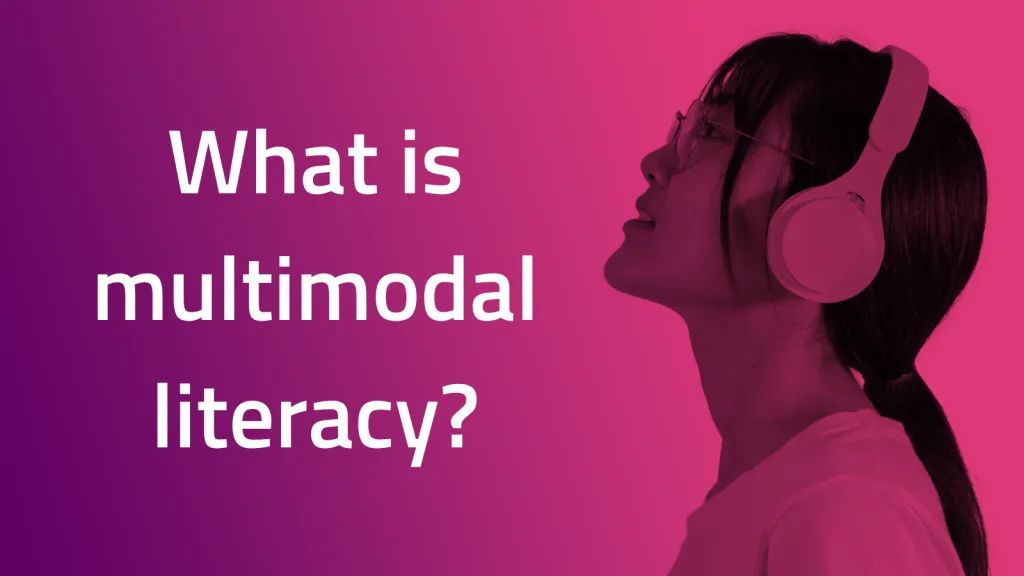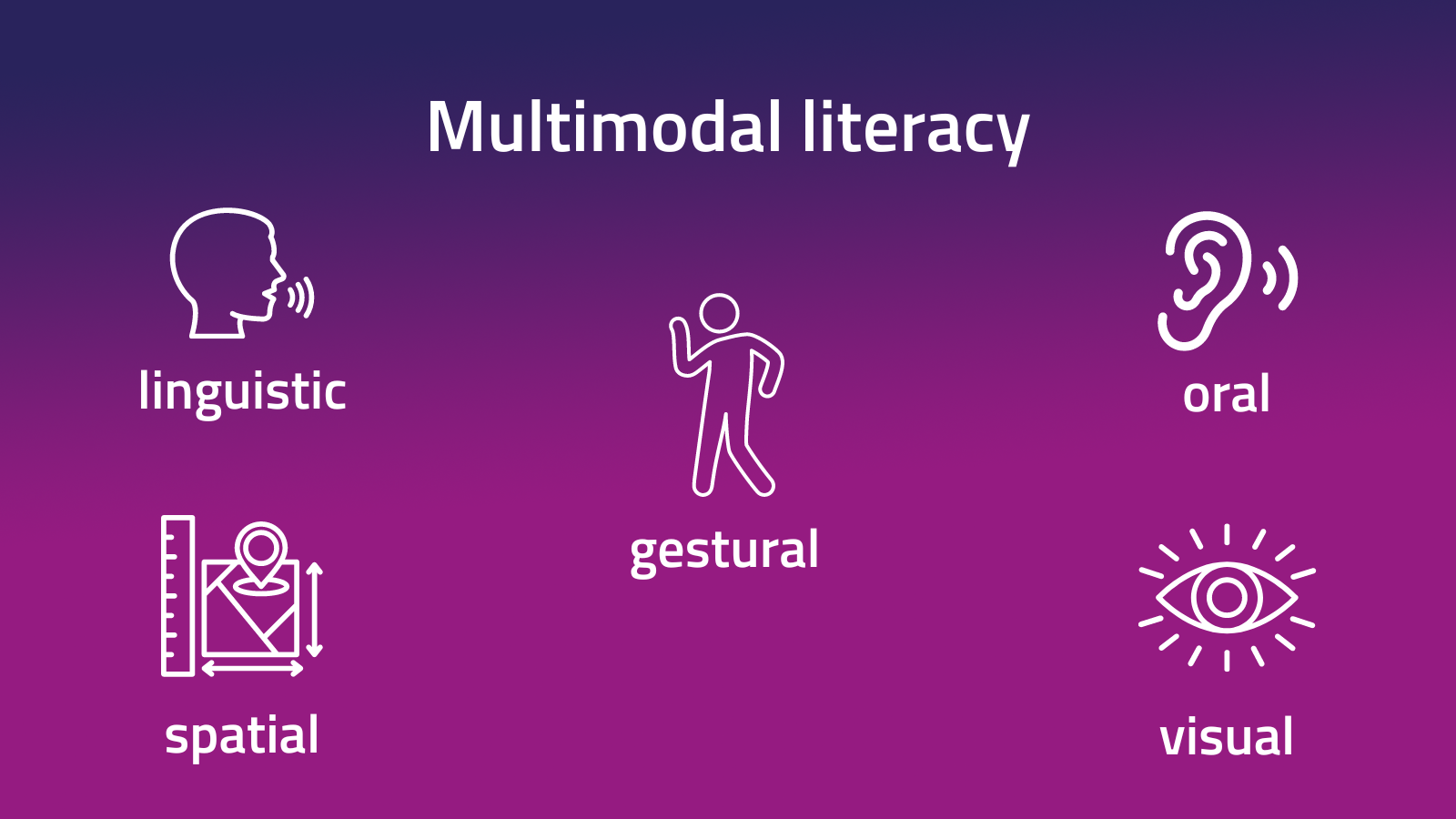What is multimodal literacy?


What is multimodal literacy?
Multimodal literacy is an important competency for serving multilingual learners. Learn the definition of multimodal literacy and the five modalities, how to make lessons beneficial for a variety of learning styles, an overview of Universal Design for Learning, and more.
Amongst households and friends, there is a common debate: subtitles on or off during a TV show? Some people feel distracted by the subtitles during a TV show or movie, while others need them or miss major plot points happening through the dialogue. This is just one example of the different modes that can be used to communicate information and how the most effective mode will be different for different people. This concept is important to bring into our classrooms when we design our instruction and learning opportunities for our students.
While some may prefer to enjoy a movie without captions and some like them, we can all agree that if we are watching a foreign film in a language that we are not fluent in, subtitles in our language are essential to understanding. On the other hand, without subtitles, we may be able to understand some of what’s happening by watching facial expressions, hearing tones, or using context clues in a scene. If we could only watch but not hear, or only hear but not watch, it would be nearly impossible. In the same way, scaffolding language and incorporating all the different modes of communication is beneficial to all students but essential for our English learners.
Read on to learn more about multimodal literacy, Universal Design for Learning, and how this can all be applied to better serve our multilingual learners.
What is multimodal literacy?
“Multimodal literacy” means that two or more means or types of communication are being used and aims to utilize multiple senses or modalities during the learning process. The purpose is to engage all students with all learning styles.

The five different modes are visual (what you can see), oral (related to listening), linguistic (using words), gestural (using the body or movement), and spatial (physical layout). There are a multitude of ways that these can be applied in a classroom setting; some examples include:
- Visual: viewing a painting, photograph, or illustration
- Oral: listening to instrumental music
- Visual + gestural: viewing sign language, body language
- Visual + linguistic: reading a book
- Visual + oral + linguistic: watching a video with subtitles
If you think through your normal day-to-day activities, you will notice that it is rare to have one of these modes in isolation. Naturally, our communication tends toward multimodality, and it is important that our classrooms reflect this.
Making a lesson multimodal
When considering multimodality in a lesson, a teacher can first focus on offering multiple means of input, or ways the information is being shared with students. If a teacher typically does a lecture-format of instruction where they stand at the front of the class and speak, this is only really helpful to students who learn well orally and linguistically. There are a number of ways to add more modalities and incorporate other learning styles:
- Include a slide deck with lots of images and graphics (+ visual).
- Use a video to provide the content during the lesson (visual + aural + linguistic).
- Using motions to convey meaning, particularly with younger grades (+ gestural)
After diversifying the means for input, we can also re-think output, or how we allow students to express their learning. A typical approach might be a written assessment, which is primarily beneficial for linguistic learners. But can students also show their understanding visually by drawing an image to show what they know? Can students share their learning through a video presentation or a recording or podcast?
These are all ways to make any unit of instruction more multimodal by increasing the input modes and providing a choice of output modes.
UDL: Essential for some, good for all
Universal Design for Learning (UDL) is an approach to instruction that is closely related to multimodal learning in that it is intended to be used and understood by everyone, with genuine learning opportunities for every student. The basic principles of UDL are multiple means of representation (the presentation of the content), multiple means of expression (the product or output), and multiple means of engagement (the process of learning). The ultimate goal is to remove unnecessary barriers to learning and allow every student to succeed. We will dive further into UDL in a future post, but an important takeaway is the recognition that every student will learn and show their learning differently, and as teachers, it is our responsibility to create a learning environment that is not solely designed for one type of learner to succeed.
There’s no such thing as an average student, but too often in education, we have instilled this idea. We use bell curves to see which students are above or below the line, but really, the average student is a myth.
Supporting ELs in a variety of learning styles
At the crux of effective education is providing authentic learning opportunities for students to apply and engage with content. We know the importance of opportunities for students to learn not just in the interpretive mode (through listening, reading, and viewing) but also - through the expressive mode (speaking, writing, and representing).
“The person doing the talking is doing the thinking, the person doing the thinking is doing the learning.” By this logic, it is imperative to build in opportunities for students to speak and generate output around the content - but this is especially true for our language learners. For these students, the opportunity to apply vocabulary and new academic language in context is vital for language acquisition as well as mastering content. There may be misconceptions that the ELs cannot engage with grade-level content without grade-level language skills, but in reality, the key is just to ensure that there is comprehensible input and some choice in output, which means allowing students to use different modes to express understanding or offering support through sentence frames and visuals.
The more opportunities and ways in which MLs can be exposed to language and practice using it, the better their overall educational experience will be. By building a learning environment that is centered around incorporating multimodal learning and can cater to any type of learner, teachers are increasing access to educational equity.
This blog was written in partnership with Amy King, Assistant Director of Educator Engagement at WCEPS. King has more than 20 years of experience in the field of English language teaching and learning both in the US and overseas. Before joining WCEPS, Ms. King was a Senior Professional Learning Specialist at WIDA for more than six years. She holds a BS in Speech and an MS in Journalism from Northwestern University near Chicago. She earned a TESOL Certificate from American University in Washington, DC and a Multiple–Subject Teaching Credential from National University in San Diego. In addition to certificates in Blended Learning, Microlearning, and E–Learning, she earned a Master of Instructional Design from the Association of Talent Development. She also holds a MS with distinction in Educational and Instructional Technology from National University.
References:
Thibodeau, Tom. “The Science and Research behind the UDL Framework.” Novak Education - UDL, MTSS, and Inclusive Practices PD for Educators, Novak Educational Consulting, 3 Oct. 2023, www.novakeducation.com/blog/the-science-and-research-behind-the-udl-fram....
“New Jersey Department of Education.” Universal Design for Learning (UDL), www.nj.gov/education/njpss/resources/udl.shtml.